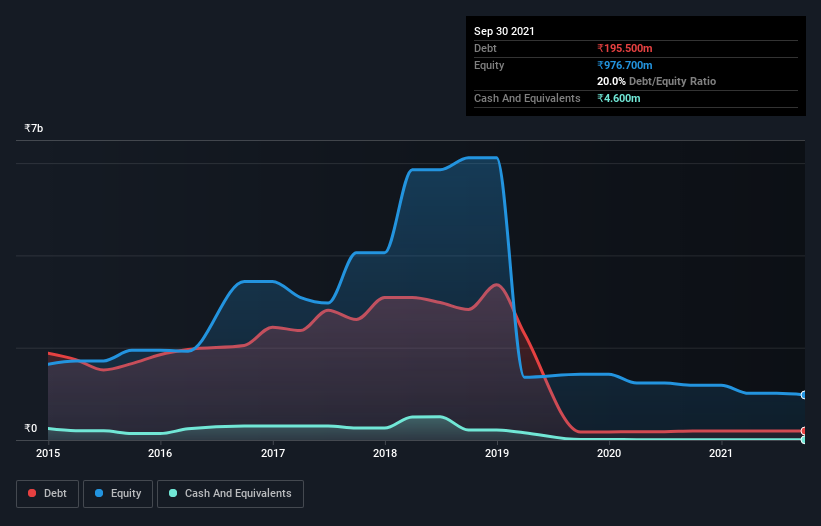- India
- /
- Metals and Mining
- /
- NSEI:KRIDHANINF
Here's Why Kridhan Infra (NSE:KRIDHANINF) Can Afford Some Debt

Some say volatility, rather than debt, is the best way to think about risk as an investor, but Warren Buffett famously said that 'Volatility is far from synonymous with risk.' When we think about how risky a company is, we always like to look at its use of debt, since debt overload can lead to ruin. Importantly, Kridhan Infra Limited (NSE:KRIDHANINF) does carry debt. But should shareholders be worried about its use of debt?
Why Does Debt Bring Risk?
Debt assists a business until the business has trouble paying it off, either with new capital or with free cash flow. Part and parcel of capitalism is the process of 'creative destruction' where failed businesses are mercilessly liquidated by their bankers. However, a more usual (but still expensive) situation is where a company must dilute shareholders at a cheap share price simply to get debt under control. Having said that, the most common situation is where a company manages its debt reasonably well - and to its own advantage. When we examine debt levels, we first consider both cash and debt levels, together.
Check out our latest analysis for Kridhan Infra
How Much Debt Does Kridhan Infra Carry?
As you can see below, Kridhan Infra had ₹195.5m of debt, at September 2021, which is about the same as the year before. You can click the chart for greater detail. However, it does have ₹4.60m in cash offsetting this, leading to net debt of about ₹190.9m.

How Healthy Is Kridhan Infra's Balance Sheet?
According to the last reported balance sheet, Kridhan Infra had liabilities of ₹562.9m due within 12 months, and liabilities of ₹24.6m due beyond 12 months. On the other hand, it had cash of ₹4.60m and ₹486.3m worth of receivables due within a year. So its liabilities total ₹96.6m more than the combination of its cash and short-term receivables.
Of course, Kridhan Infra has a market capitalization of ₹537.4m, so these liabilities are probably manageable. However, we do think it is worth keeping an eye on its balance sheet strength, as it may change over time. The balance sheet is clearly the area to focus on when you are analysing debt. But it is Kridhan Infra's earnings that will influence how the balance sheet holds up in the future. So when considering debt, it's definitely worth looking at the earnings trend. Click here for an interactive snapshot.
Over 12 months, Kridhan Infra reported revenue of ₹284m, which is a gain of 169%, although it did not report any earnings before interest and tax. So its pretty obvious shareholders are hoping for more growth!
Caveat Emptor
Even though Kridhan Infra managed to grow its top line quite deftly, the cold hard truth is that it is losing money on the EBIT line. To be specific the EBIT loss came in at ₹14m. Considering that alongside the liabilities mentioned above does not give us much confidence that company should be using so much debt. So we think its balance sheet is a little strained, though not beyond repair. Another cause for caution is that is bled ₹16m in negative free cash flow over the last twelve months. So suffice it to say we do consider the stock to be risky. When analysing debt levels, the balance sheet is the obvious place to start. However, not all investment risk resides within the balance sheet - far from it. For example Kridhan Infra has 5 warning signs (and 3 which make us uncomfortable) we think you should know about.
When all is said and done, sometimes its easier to focus on companies that don't even need debt. Readers can access a list of growth stocks with zero net debt 100% free, right now.
If you're looking to trade Kridhan Infra, open an account with the lowest-cost platform trusted by professionals, Interactive Brokers.
With clients in over 200 countries and territories, and access to 160 markets, IBKR lets you trade stocks, options, futures, forex, bonds and funds from a single integrated account.
Enjoy no hidden fees, no account minimums, and FX conversion rates as low as 0.03%, far better than what most brokers offer.
Sponsored ContentValuation is complex, but we're here to simplify it.
Discover if Kridhan Infra might be undervalued or overvalued with our detailed analysis, featuring fair value estimates, potential risks, dividends, insider trades, and its financial condition.
Access Free AnalysisHave feedback on this article? Concerned about the content? Get in touch with us directly. Alternatively, email editorial-team (at) simplywallst.com.
This article by Simply Wall St is general in nature. We provide commentary based on historical data and analyst forecasts only using an unbiased methodology and our articles are not intended to be financial advice. It does not constitute a recommendation to buy or sell any stock, and does not take account of your objectives, or your financial situation. We aim to bring you long-term focused analysis driven by fundamental data. Note that our analysis may not factor in the latest price-sensitive company announcements or qualitative material. Simply Wall St has no position in any stocks mentioned.
About NSEI:KRIDHANINF
Kridhan Infra
Manufactures and sells steel products in India and internationally.
Medium-low with worrying balance sheet.
Market Insights
Community Narratives



